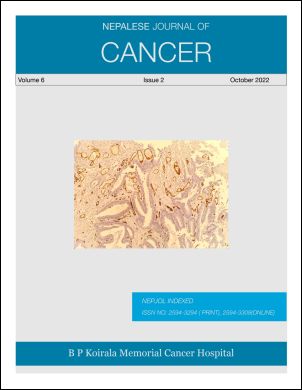Incidence of Cancer in Nepal: A Three-Year Trend Analysis
DOI:
https://doi.org/10.3126/njc.v6i2.58214Keywords:
Cancer Incidence, Nepal, Registry, Public HealthAbstract
Background: Cancer is a major public health problem in the world. This study aims to present a three-year trend of cancer incidence in Nepal.
Methods: This study used the three-year data of National Cancer Registry Program (NCRP) from January 2013 to December 2015. NCRP currently includes 12 major hospitals where diagnostic treatment facilities are available and represent the majority of the cases in Nepal. Descriptive analysis was used to present the demographic profile of the participants and the incidence of different topography of cancer. Age-specific and age-adjusted cancer incidence per 100,000 population were presented.
Results: A total of 27,483 new cancer cases were included in the study. The age-adjusted incidence rates were 39.1, 39.8 and 41.8 per 100,000 population in the year 2013, 2014 and 2015 respectively. The most common cancer in Nepal was lung followed by cervical, breast, stomach and colorectal cancer. Among males, lung cancer was the most common followed by lip and oral cavity, stomach, colorectal cancer and leukemia and among females, cervical cancer followed by breast, lung, ovary and stomach.
Conclusion: Cancer incidence is rising in Nepal and thus comprehensive policies targeting prevention, early detection, and treatment programs should be carried out.
Downloads
Downloads
Published
How to Cite
Issue
Section
License
Copyright (c) 2022 Nepalese Journal of Cancer

This work is licensed under a Creative Commons Attribution 4.0 International License.
This license lets others distribute, remix, tweak, and build upon your work, even commercially, as long as NJC and the authors are acknowledged.
Submission of the manuscript means that the authors agree to assign exclusive copyright to NJC. The aim of NJC is to increase the visibility and ease of use of open access scientific and scholarly articles thereby promoting their increased usage and impact.




